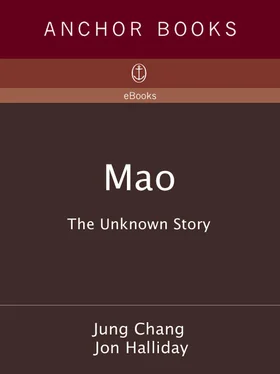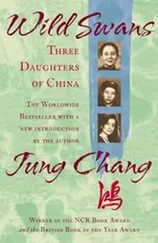Nearby, deep in a wood, the Communists built a camouflaged auditorium with a capacity of 2,000, whose excellent acoustics were designed to make up for the absence of microphones. It was octagonal, shaped like the Red Army cap of the day. The façade was reminiscent of a European cathedral, only with shuttered windows, through which people could look out, but not in. Above the central gate was an enormous red star with a globe bulging out in the middle, firmly locked in by a hammer and sickle. Next to the auditorium was an air-raid shelter capable of holding over 1,000 people, with two access doors located just behind the stage, so that the leaders could reach it first.
The leaders lived in a mansion which had belonged to the richest person in the village, situated to one side of the clan temple now turned government office. Here Mao chose the best accommodation, a corner suite at the back with a window looking out onto the temple. This window was specially made for him, as the previous owner, out of deference for the temple, would not have any windows overlooking it. Mao also had a brick floor laid over the timber to keep out rats.
The land abutting the leaders’ residence was taken over to house guards and orderlies, as well as high-security installations like the gold store, the switchboard and the radio station. Apart from some villagers kept on to work as servants, the rest were evicted en masse, and the whole area was barricaded off from the outside. None of the Party bosses was able to speak the local dialect, and most made no effort to learn, so they needed interpreters to communicate with the locals, with whom they had little contact anyway. Cadres from the region acted as their links. It was the style and pattern of an occupying army.
ON 7 NOVEMBER 1931, Ruijin held a grand celebration to mark the founding of the Red state. That evening, tens of thousands of locals were organized to put on a parade, holding bamboo torches and lanterns in the shape of stars or hammers and sickles. The streams of lights simmered against the darkness of the night, producing quite a spectacle. There were drums and firecrackers and skits, one with a “British imperialist” driving before him prisoners in chains labeled “India” and “Ireland.” A generator, roaring in an air-raid shelter by the side of the temple, produced electricity, which shone in the numerous small bulbs arrayed along wires slung from pillar to pillar. They illuminated the endless banners and slogans of different colors that also hung from the wires — as well as giant red, white and black posters on the walls. Mao and the other leaders stood on the presidium, clapping and shouting slogans, as the procession passed below them. This was Mao’s first taste of future glories when up to a million people would hail him on Tiananmen.
But here there was one vital difference: Mao in Ruijin was not the supreme leader. Although Moscow made him the “president” and the “prime minister,” it did not make him the dictator. Instead it surrounded him with other men whom it could trust to obey its orders. At the top of the army was Zhu De, who was appointed chief of the Military Council. Zhu had been trained in Russia, and the Russians knew him — and knew that he was loyal. Moscow had earlier considered Mao for the post, but had changed its mind. He ended up as only one of the Council’s fifteen ordinary members.
Most importantly, Mao had a direct, on-the-spot Chinese boss: Chou En-lai, who was to arrive from Shanghai in December 1931, the month after the regime was established, and take up the post of Party chief. In the Communist system, Party boss was the highest authority, above the head of state. With Chou’s arrival, the center of the Party itself shifted to Ruijin, and Shanghai became little more than a liaison office with the Russians. Reliable radio communication was established between Ruijin and Moscow, via Shanghai, where a young man called Po Ku was in charge. The person controlling communication with Moscow was not Mao but Chou En-lai. It was Chou who built Ruijin into a Stalinist state. Mao was not the main person responsible for the foundation and operation of Red Ruijin.
Chou was a master of organization, and under him the whole society was dragooned into an all-encompassing, interlocking machine. He was instrumental in building a huge bureaucracy, whose job was not only to run the base, but also to coerce the population into executing Party orders. In any one village, the state set up dozens of committees—“recruitment committee,” “land committee,” “confiscation committee,” “registration committee,” “red curfew committee,” to name but a few. People first got enmeshed in an organization from the age of six, when they had to join the Children’s Corps. At the age of fifteen, they were automatically enrolled in the Youth Brigade. All adults except the very old and crippled were put into the Red Defense Army. In this way, the entire population was regimented, and a web of control was formed.
This machine was an eye-opener to Mao. Before Chou arrived, Mao had ruled the Red land in bandit style, with less regimentation of the population as a whole; but it did not take long for him to appreciate the advantages and potential of the new way. When he eventually took power nationwide, he inherited this totalitarian machine and made it even more seamless and intrusive than Ruijin — or Stalin’s Russia. And he retained Chou’s services till Chou’s last breath.
Chou had also founded the Chinese KGB, then called the Political Security Bureau, under Moscow’s supervision, in 1928. He and his assistants brought the system into Ruijin, and kept the state alive via terror. Whereas Mao had been using terror for personal power, Chou employed it to bolster Communist rule. The henchmen Mao used for his purges had been cynical and corrupt, and out for personal gain. Chou employed Soviet-trained professionals.
When Chou first arrived in Ruijin at the end of 1931, he had adjudged Mao’s purge methods as not altogether correct. Mao had “relied entirely on confessions and torture,” and “caused terror in the masses.” Chou rehabilitated some victims. One man recalled the process. An official
took out a notebook and began to read out names. Those whose names were read out were ordered to go and stand in the inner courtyard under armed guards. There were scores of names … Mine was called, too. I was so frightened I sweated all over. Then we were questioned one by one, and cleared one by one. In no time, all the detainees were released. And all the incriminating confessions were burned on the spot …
But within a matter of months Chou had brought this respite to an end. Even so short a period of rehabilitation and easing up had released a groundswell of dissidence. “Relaxing about purges caused counter-revolutionaries … to raise their heads again,” Chou’s security men noted aghast. And as people thought, wishfully, that there would be “no more killings,” “no more arrests,” they started to band together to defy Communist orders. It rapidly became clear that the regime could not survive without constant killings, and killing soon restarted.
THE RED STATE regarded its population as a source of four main assets: money, food, labor and soldiers, first for its war, and ultimately to conquer China.
There was a big money-spinner in the region — the largest deposit in the world of tungsten, an extremely valuable strategic mineral that had previously been mined by a consortium of foreign capital. The Red regime resumed mining at the beginning of 1932. With soldiers and slave laborers as miners, the tungsten was exported across the Reds’ southern border to the Cantonese warlords who, though White, were anti-Chiang, and eager to make money. The Red area was in theory under blockade, yet trade with the Cantonese boomed, even when they and the Red Army were sometimes fighting each other. Salt, cotton, medicine and even arms, were openly trucked in, in exchange for tungsten. The operation was run by Mao’s brother Tse-min, who was head of the state bank.
Читать дальше










